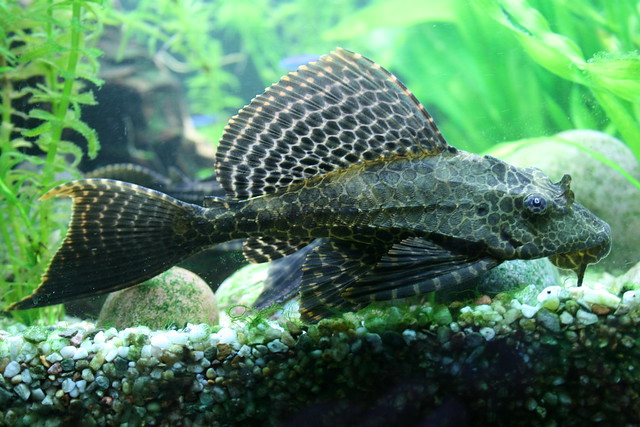By now, your guppies have settled into their tank and you have enjoyed getting to know and enjoy them. I imagine your confidence has soared and you have the urge to have some different inhabitants. This is where the term community tank takes its meaning. Not all fish make good companions for other fish.
 |
| Photo by Frank Boston (bostonsphotos) (cc) |
My favorite addition to a community tank is catfish, the very shy algae eaters that scoot from dark corner to an even darker hiding place. The catfish live primarily on the bottom of the tank but you will see them moving all-around the tank attached to the glass with the sucker mouths they possess or moving in a flash through the water. While the catfish I have are pleco‘s, they are just one of over 2000 species. The common plecostomus can live a long time, and you have to be aware that these fish can grow quite large.
They do like the vegetable matter to form the greater proportion of their diet. They will eat sliced courgette or peas with gusto! Pseudo fights for ownership of peas dropped into the tank will happen between the guppies and catfish. They will also clean up dropped food after the guppies. There are also specific foods just for the pleco and they feel very special getting these treats. These fish have wonderful personalities if they qualify as having one! I have always had bogwood in the tanks; the pleco does like these and during the day will hide or spend time on or around the bogwood. The male has more whiskers that are prominent on his snout, where the female has a more reduced number just around her nose.

The breeding habits of the bristle nose pleco are interesting to see. If you have provided a cave or tube like structure for them to hide in or under, you may notice the male “sweeping” or tidying the house. The female appears to attach the eggs to the walls of what ever the adults have elected to use. The egg sacs are noticeable in that they are an orange color. This color makes them very noticeable to the fry “eating” guppies. The male will spend time causing water movement into the cave for the young.The parents seem to watch the small pleco’s but you will only know they are in your tank when you see the little fish amongst the pebbles and plants in the bottom of the tank. Guppies will eat anything they find so you will need good hiding places to read any real number of the little pleco. These are excellent fish to have in a community tank.
By Maman Wilson - Article Source: EzineArticles
|

No comments:
Post a Comment